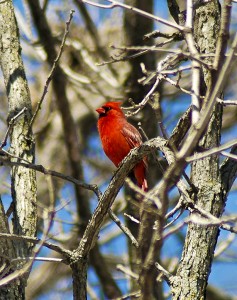
Photo by Tom Baker
The song of both male and female Northern Cardinals (Cardinalis cardinalis cardinalis) is a series of clear, bubbly notes that have been describes as woit, woit, woit, chew, chew, chew, chew, chew or pichew, pichew, tiw, tiw, tiw, tiw, tiw (Sibley); and cheer, cheer, cheer or birdie, birdie, birdie (Cornell Lab of Ornithology). It is a learned song and varies by region.
In the spring a male seeking to attract a female gives an inspiring vocal performance that must be listened to for several minutes to be fully appreciated. It begins with a series of just five or six notes; woit, woit, chew, chew, chew. After a pause of few seconds the series is repeated, increasing the number of chew notes by just one. This continues for several minutes, each time the series increasing by just a single note. The series will often get to 18 to 20 chew notes. One series I counted reached 24 chew notes. You do not have to be a female Northern Cardinal to be impressed by such a performance.
I have yet to hear a recording or read an account of this extended series of calls.
http://www.minnesotaseasons.com/Birds/Northern_Cardinal.html





